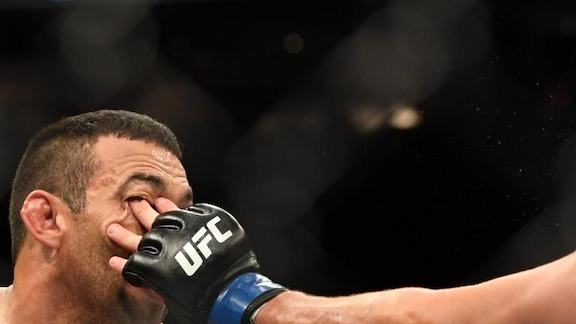Cry Foul and Let Slip the Dogs of War
Using UFC fouls as the basis for operational success in violence.
Contrary to popular belief, combat sports are not about injury. In fact, they go to great lengths to make the contest as “safe” as possible so that competitors can have lucrative careers that generate profits for a good chunk of time. A rotating stable of fighters makes more money than having people get functionally retired every time they lose a 10-second match. The 27 fouls in the UFC are specifically designed to make debilitating injury the least likely outcome—for our purposes, this makes the list a pretty good roadmap for what to do first in violence. It turns out that not all the fouls are useful guideposts; some are definite yesses, fewer are iffy, and two are flat-out wrong. Here they are, with commentary:
DEFINITE YESSES
2. Eye gouging of any kind.
9. Fingers outstretched toward an opponent’s face/eyes.
The eyes are one of the three targets that don’t require body weight for serious injury. A pinky nail across the cornea is all that’s needed to blind someone. And to quote Master Derrick, “Violence is the race for the eye.”
5. Hair pulling.
See 19, below.
6. Spiking an opponent to the canvas on his head or neck.
Your doctor would tell you to never, ever do this. Especially if by “canvas” you mean “parking lot”.
7. Strikes to the spine or the back of the head.
‘Nuff said.
8. Throat strikes of any kind, and/or grabbing the trachea.
The trachea is the second of three that do not require body weight for injury; grip strength gets it done.
10. Downward-pointing elbow strike (12 o’clock to 6 o’clock strike).
This is contraindicated due to “accidental” body weight transfer. Downward means gravity-assisted, which means falling body weight; using the elbow rather than the lower arm or hand means the removal of strength as a factor. This changes it from a punch to a strike (as we define it). The point of the elbow is the smallest, hardest striking surface. Add it all up and you have people “accidentally” doing an ideal strike. Line it up with a target (oh, like the spine or neck of a grounded person) and you have a guaranteed fight-ender.
11. Groin attacks of any kind.
The groin is the last of the “Anti-Wrasslin’ Trifecta”—no body weight required to cause serious injury. Get a fistful of soft tissue and haul yourself into your next target. Better phrased as “Groin attacks of every kind.”
12. Kneeing and/or kicking the head of a grounded opponent.
13. Stomping a grounded opponent.
Again, the “accidental” inclusion of body weight, driven home by leg strength and front-ended by a part of your body that’s meant for rough business (your foot). All that effort is back-ended by the planet—the body has no way of moving to dissipate the force—meaning all the work comes out inside anatomy. Could result in actual, fight-ending injury.
14. Holding opponent’s gloves or shorts.
Falls under the aegis of 5, above, and 19, below. Useless in isolation, brilliant in conjunction with a throw.
15. Holding or grabbing the fence or ropes with fingers or toes.
Typically employed when stomping or kicking a downed person. Adds leverage and improves follow-through.
16. Small joint “manipulation”.
(Quotes mine.) As long as this is really code for “breaking fingers”, I’m all for it. Personally, if I were going to use code, I’d say something like “forcible removal of all future piano concertos.”
17. Throwing an opponent out of the ring/fighting area.
Okay, bear with me on this one. I take it to mean “throwing into a not-nice place” like a fire hydrant. Or a plate glass window. Or traffic.
19. Clawing, pinching or twisting the flesh.
By itself, this doesn’t make the cut, as it’s simply painful. As an adjunct to something vicious (like a throw or joint break) it’s wonderful. To the trained operator the human body is like a jumpsuit with handles all over it. Except that the handles are all sewn into the bones…
22. Flagrant disregarding of the referee’s instructions.
Violence is the time to jettison those pesky social mores. You are free to do as you will, beholden only to the physical laws of the universe.
23. Unsportsmanlike conduct that causes injury to an opponent.
Goes without saying.
24. Attacking an opponent after the bell has sounded the end of the period of unarmed combat.
25. Attacking an opponent on or during the break.
26. Attacking an opponent who is under the care of the referee.
AKA “attacking unexpectedly”. But isn’t that the best time?
27. Interference from a mixed martial artist’s corner or seconds.
Yes, your mates are free to pitch in. Many hands make light work, and all that.
IFFY
1. Butting with the head.
Goes without saying. Can it work? Sure. Ask a Scotsman… from a distance. Is it a good idea? Hardly.
3. Biting or spitting at an opponent.
Three little words: BLOOD-BORNE PATHOGENS. Can it work? Sure. As an omega option. I bet you ten bucks you can figure out something better to do first.
4. Fish hooking.
I actually know a guy who was in a headlock and went for the eyes and missed and ended up fish-hooking the guy instead. It did make the guy let go. This is anecdotal and your mileage may vary. The danger of getting your fingers chewed should dissuade you.
18. Intentionally placing a finger into any orifice or any cut or laceration of an opponent.
Again, this is just discomfort. But if we take it to mean “rolling ‘em over with a broken arm” then I’m all for it.
20. Timidity, including, without limitation, avoiding contact with an opponent, intentionally or consistently dropping the mouthpiece or faking an injury.
This one’s iffy. I take it to mean “social manipulation to gain advantage” (see 24-26, above). But that would only really apply in antisocial situations, wouldn’t it?
FLAT-OUT NO EFFIN’ WAY
21. Using abusive language in the fighting area.
Once you break the social plane and cross over into violence, there is no communication.
AND THE ONE THAT’S NO LONGER A FOUL FOR SOME REASON
X. Throwing in the towel during “competition”.
(Quotes mine.) In violence if you quit, you die. End of story.
— Chris Ranck-Buhr (from 2006, revised 2021)



Leave a Reply
Want to join the discussion?Feel free to contribute!